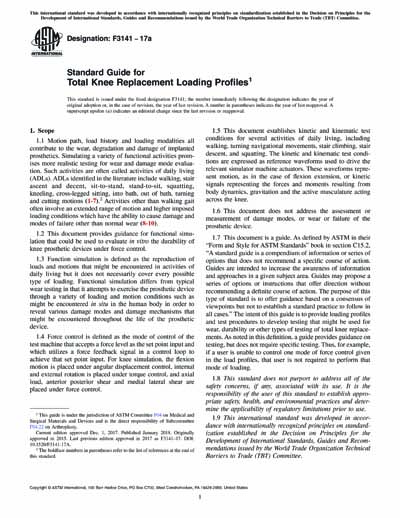Historical
ASTM F3141-17a
Standard Guide for Total Knee Replacement Loading Profiles
1.1 Motion path, load history and loading modalities all contribute to the wear, degradation and damage of implanted prosthetics. Simulating a variety of functional activities promises more realistic testing for wear and damage mode evaluation. Such activities are often called activities of daily living (ADLs). ADLs identified in the literature include walking, stair ascent and decent, sit-to-stand, stand-to-sit, squatting, kneeling, cross-legged sitting, into bath, out of bath, turning and cutting motions (1-7).2 Activities other than walking gait often involve an extended range of motion and higher imposed loading conditions which have the ability to cause damage and modes of failure other than normal wear (8-10).
1.2 This document provides guidance for functional simulation that could be used to evaluate in vitro the durability of knee prosthetic devices under force control.
1.3 Function simulation is defined as the reproduction of loads and motions that might be encountered in activities of daily living but it does not necessarily cover every possible type of loading. Functional simulation differs from typical wear testing in that it attempts to exercise the prosthetic device through a variety of loading and motion conditions such as might be encountered in situ in the human body in order to reveal various damage modes and damage mechanisms that might be encountered throughout the life of the prosthetic device.
1.4 Force control is defined as the mode of control of the test machine that accepts a force level as the set point input and which utilizes a force feedback signal in a control loop to achieve that set point input. For knee simulation, the flexion motion is placed under angular displacement control, internal and external rotation is placed under torque control, and axial load, anterior posterior shear and medial lateral shear are placed under force control.
1.5 This document establishes kinetic and kinematic test conditions for several activities of daily living, including walking, turning navigational movements, stair climbing, stair descent, and squatting. The kinetic and kinematic test conditions are expressed as reference waveforms used to drive the relevant simulator machine actuators. These waveforms represent motion, as in the case of flexion extension, or kinetic signals representing the forces and moments resulting from body dynamics, gravitation and the active musculature acting across the knee.
1.6 This document does not address the assessment or measurement of damage modes, or wear or failure of the prosthetic device.
1.7 This document is a guide. As defined by ASTM in their “Form and Style for ASTM Standards” book in section C15.2, “A standard guide is a compendium of information or series of options that does not recommend a specific course of action. Guides are intended to increase the awareness of information and approaches in a given subject area. Guides may propose a series of options or instructions that offer direction without recommending a definite course of action. The purpose of this type of standard is to offer guidance based on a consensus of viewpoints but not to establish a standard practice to follow in all cases.” The intent of this guide is to provide loading profiles and test procedures to develop testing that might be used for wear, durability or other types of testing of total knee replacements. As noted in this definition, a guide provides guidance on testing, but does not require specific testing. Thus, for example, if a user is unable to control one mode of force control given in the load profiles, that user is not required to perform that mode of loading.
1.8 This standard does not purport to address all of the safety concerns, if any, associated with its use. It is the responsibility of the user of this standard to establish appropriate safety, health, and environmental practices and determine the applicability of regulatory limitations prior to use.
1.9 This international standard was developed in accordance with internationally recognized principles on standardization established in the Decision on Principles for the Development of International Standards, Guides and Recommendations issued by the World Trade Organization Technical Barriers to Trade (TBT) Committee.
Content Provider
ASTM International [astm]






